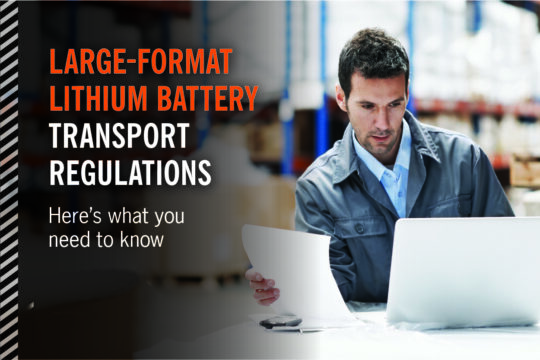
Compliantly shipping lithium-ion batteries of any size means navigating a complex set of regulations. And, generally speaking, the bigger the batteries get, the more challenging they are to transport compliantly.
When you’re moving large format lithium-ion batteries—like the ones for electric vehicles, solar power storage, data centers and other heavy-duty purposes—you have to consider a number of regulatory factors that just don’t come into play with, say, batteries for your laptop.
Understanding these regulations is one important part of shipping large format lithium batteries safely and compliantly.
These regulations—contained in 49 CFR 173.185 for shipping within the U.S.—are essentially governed by three characteristics of your battery: power capacity, weight and condition. The mode of transportation also determines some of the shipping requirements. Let’s take a closer look.
Power capacity makes large format lithium-ion batteries fully regulated
For transport within the United States, any lithium-ion battery with more than 100 Wh power capacity is a fully regulated, Class 9 hazardous material. (By highway or rail only, there’s an additional exception for batteries up to 300 Wh.) Lithium batteries powerful enough for electric vehicles and other heavy-duty purposes are typically rated at 40 KWh or higher—equivalent to 40,000 watt-hours—so they’re obviously well above that threshold.
(Individual modules of cellular module assemblies—also known as CMAs—are also likely to have capacity significantly higher than 300 Wh.)
As fully regulated, Class 9 shipments, each of these batteries requires:
- A Cargo Aircraft Only label (for transport by air)
- A Class 9 lithium battery label, UN number and proper shipping name
- A Dangerous Goods Declaration
- UN specification packaging rated to a minimum Packing Group II (Y)
- Training in Fully Regulated lithium battery transport for all employees involved in handling these packages
Since any lithium battery in this class has capacity exceeding the threshold several times over, this is the easiest regulation to understand. Your large format lithium battery is fully regulated hazmat, full stop.
Battery weight determines compliant packaging
The second factor affecting which regulations apply to your battery is its weight.
As noted above, fully regulated lithium-ion batteries can be compliantly shipped via cargo aircraft—but only when they weigh 35 kg or less. Lithium-ion batteries weighing more than 35 kg cannot be shipped by air without a competent authority approval (similar to a special permit) from the country with jurisdiction over the shipment as well as the carrier.
Since large format lithium batteries powerful enough for data centers typically weigh far more than 35 kg, your battery most likely can’t be shipped by air without a competent authority approval.
(We should also note that the above regulation applies only to batteries that are not damaged, defective or recalled. “DDR” lithium batteries can never be compliantly shipped by air, no matter what they weigh. See the next section for more details.)
The next important weight threshold is 400 kg—the boundary between bulk and non-bulk shipments.
- A battery weighing more than 400 kg is a bulk shipment, requiring a UN specification Large Packaging (example: 50D wooden crate). It also needs to be placarded, although there’s an exception that lets you mark and label it on two opposing sides instead.
- A battery weighing 400 kg or less is a non-bulk shipment, which can be shipped in certain UN specification packages that have passed all the required tests.
Electric vehicle batteries and those similar can weigh in on either side of that 400 kg threshold, so we’d advise you to work closely with an experienced partner to determine what kind of packaging will be compliant and safe for your battery.
Damaged, defective or recalled batteries have even stricter requirements
Regulations get considerably more restrictive if your large format lithium battery is damaged, defective or recalled (DDR):
- DDR lithium-ion batteries cannot be compliantly shipped by air, regardless of capacity or weight.
- DDR lithium-ion batteries require UN specification packaging rated to Packing Group I—the highest category of potential hazard. (Non-DDR batteries require UN specification packaging rated to Packing Group II.)
- DDR lithium-ion batteries require cushioning material that is absorbent, noncombustible, and electrically nonconductive. (Non-DDR batteries also require cushioning material, but without those specific requirements.)
Long story short, if your battery qualifies as DDR—say, in the event of an electric vehicle battery recall—you’ll have to jump through several more hoops to keep your shipments safe and compliant. Again, we strongly recommend you work closely with an experienced partner.
Understanding the regulations is only the beginning
Understanding the regulations governing large format lithium battery transport doesn’t give you a complete roadmap to shipping them. In fact, it’s only the beginning. You still have to consider packaging design, destinations, supply chain partners, workplace rules and other factors specific to your batteries and your organization.
That’s why you need a partner.
Only Labelmaster can offer you the Dangerous Goods experience, expertise and hands-on help you need. Read more about how to navigate the large format lithium battery transport process safely, compliantly and efficiently in our eBook, or Contact Labelmaster to learn more!
Make sure your shipments are safe and in complete compliance with a full line of solutions from Labelmaster—a full-service provider of goods and services for hazardous materials and Dangerous Goods professionals, shippers, transport operators and EH&S providers.



Nice write-up, Nikki! Everything you need to know…but were afraid to ask!
This article serves as a beacon of literary brilliance, illuminating the mind with its profound insights and stirring emotions with its eloquent prose.